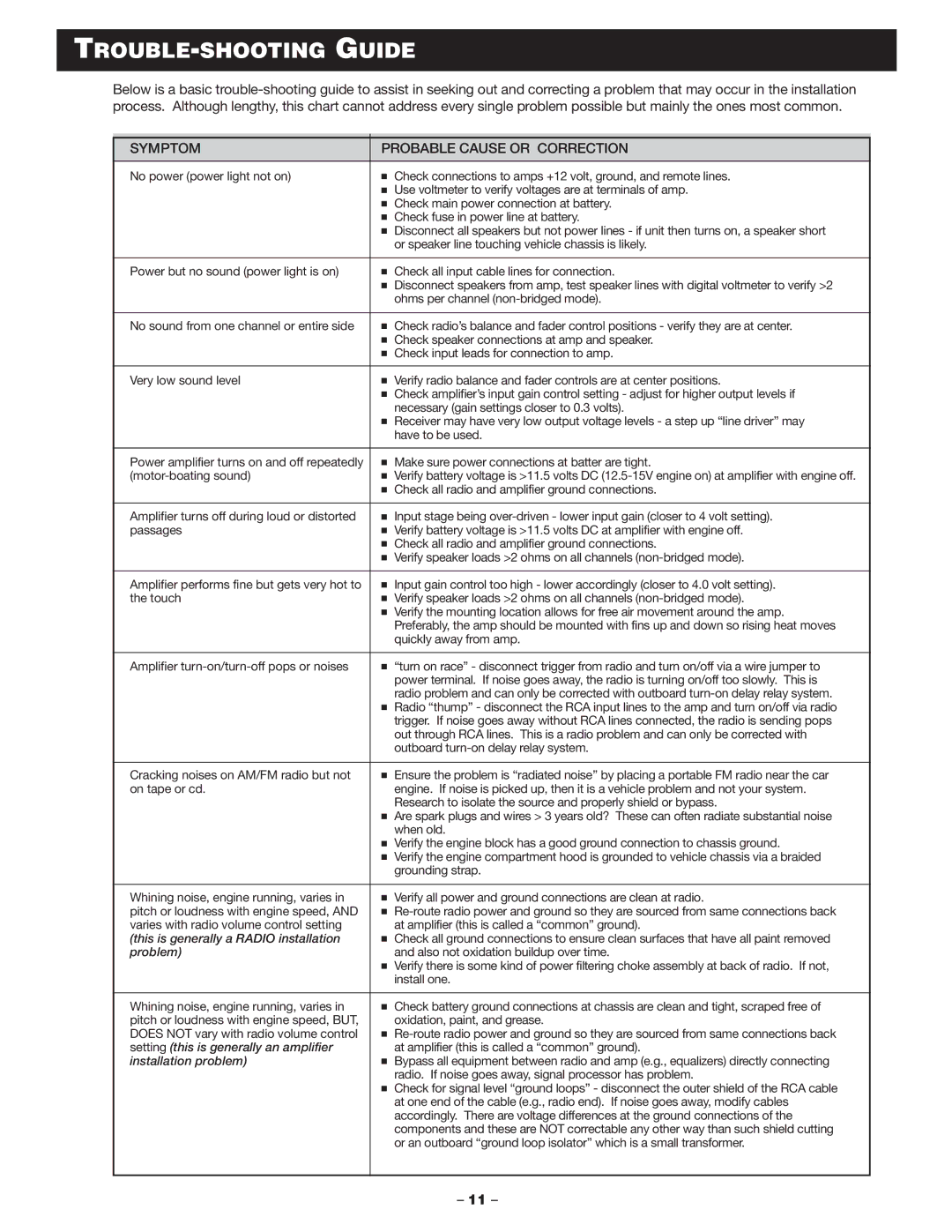TROUBLE-SHOOTING GUIDE
Below is a basic
SYMPTOM | PROBABLE CAUSE OR CORRECTION | |
No power (power light not on) | ■ | Check connections to amps +12 volt, ground, and remote lines. |
| ■ | Use voltmeter to verify voltages are at terminals of amp. |
| ■ | Check main power connection at battery. |
| ■ | Check fuse in power line at battery. |
| ■ | Disconnect all speakers but not power lines - if unit then turns on, a speaker short |
|
| or speaker line touching vehicle chassis is likely. |
|
|
|
Power but no sound (power light is on) | ■ | Check all input cable lines for connection. |
| ■ | Disconnect speakers from amp, test speaker lines with digital voltmeter to verify >2 |
|
| ohms per channel |
|
|
|
No sound from one channel or entire side | ■ | Check radio’s balance and fader control positions - verify they are at center. |
| ■ | Check speaker connections at amp and speaker. |
| ■ | Check input leads for connection to amp. |
|
|
|
Very low sound level | ■ | Verify radio balance and fader controls are at center positions. |
| ■ Check amplifier’s input gain control setting - adjust for higher output levels if | |
|
| necessary (gain settings closer to 0.3 volts). |
| ■ | Receiver may have very low output voltage levels - a step up “line driver” may |
|
| have to be used. |
|
|
|
Power amplifier turns on and off repeatedly | ■ | Make sure power connections at batter are tight. |
■ | Verify battery voltage is >11.5 volts DC | |
| ■ | Check all radio and amplifier ground connections. |
|
|
|
Amplifier turns off during loud or distorted | ■ | Input stage being |
passages | ■ | Verify battery voltage is >11.5 volts DC at amplifier with engine off. |
| ■ | Check all radio and amplifier ground connections. |
| ■ | Verify speaker loads >2 ohms on all channels |
|
|
|
Amplifier performs fine but gets very hot to | ■ | Input gain control too high - lower accordingly (closer to 4.0 volt setting). |
the touch | ■ | Verify speaker loads >2 ohms on all channels |
| ■ | Verify the mounting location allows for free air movement around the amp. |
|
| Preferably, the amp should be mounted with fins up and down so rising heat moves |
|
| quickly away from amp. |
|
|
|
Amplifier | ■ | “turn on race” - disconnect trigger from radio and turn on/off via a wire jumper to |
|
| power terminal. If noise goes away, the radio is turning on/off too slowly. This is |
|
| radio problem and can only be corrected with outboard |
| ■ | Radio “thump” - disconnect the RCA input lines to the amp and turn on/off via radio |
|
| trigger. If noise goes away without RCA lines connected, the radio is sending pops |
|
| out through RCA lines. This is a radio problem and can only be corrected with |
|
| outboard |
|
|
|
Cracking noises on AM/FM radio but not | ■ | Ensure the problem is “radiated noise” by placing a portable FM radio near the car |
on tape or cd. |
| engine. If noise is picked up, then it is a vehicle problem and not your system. |
|
| Research to isolate the source and properly shield or bypass. |
| ■ | Are spark plugs and wires > 3 years old? These can often radiate substantial noise |
|
| when old. |
| ■ | Verify the engine block has a good ground connection to chassis ground. |
| ■ | Verify the engine compartment hood is grounded to vehicle chassis via a braided |
|
| grounding strap. |
|
|
|
Whining noise, engine running, varies in | ■ | Verify all power and ground connections are clean at radio. |
pitch or loudness with engine speed, AND | ■ | |
varies with radio volume control setting |
| at amplifier (this is called a “common” ground). |
(this is generally a RADIO installation | ■ | Check all ground connections to ensure clean surfaces that have all paint removed |
problem) |
| and also not oxidation buildup over time. |
| ■ | Verify there is some kind of power filtering choke assembly at back of radio. If not, |
|
| install one. |
|
|
|
Whining noise, engine running, varies in | ■ | Check battery ground connections at chassis are clean and tight, scraped free of |
pitch or loudness with engine speed, BUT, |
| oxidation, paint, and grease. |
DOES NOT vary with radio volume control | ■ | |
setting (this is generally an amplifier |
| at amplifier (this is called a “common” ground). |
installation problem) | ■ | Bypass all equipment between radio and amp (e.g., equalizers) directly connecting |
|
| radio. If noise goes away, signal processor has problem. |
| ■ | Check for signal level “ground loops” - disconnect the outer shield of the RCA cable |
|
| at one end of the cable (e.g., radio end). If noise goes away, modify cables |
|
| accordingly. There are voltage differences at the ground connections of the |
|
| components and these are NOT correctable any other way than such shield cutting |
|
| or an outboard “ground loop isolator” which is a small transformer. |
|
|
|
– 11 –
